#215: Camarops petersii, The Dog’s Nose Fungus
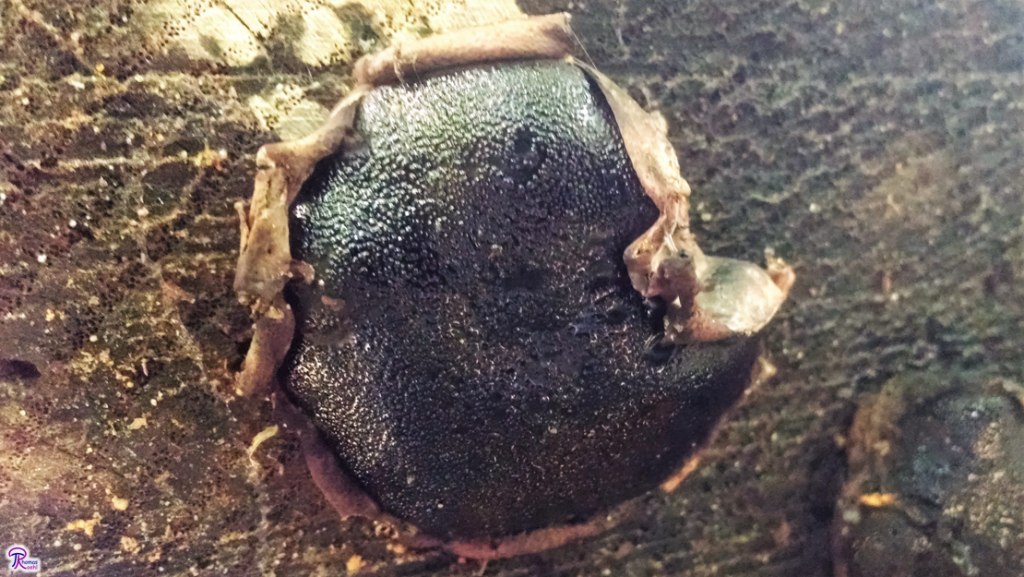
Camarops petersii, the Dog’s Nose Fungus, is a distinctive mushroom whose surface is reminiscent of the color and texture of a dog’s nose. The pimply black surface is covered in black spore slime, so expect your fingers to get messy if you touch it.
Camarops petersii is one of the more alien-looking things you’ll come across in the woods of eastern North America. It looks like someone had a glob of tar in a paper bag, set the bag down on a log, and ripped away most of the bag leaving the tar sitting on a ripped circle of paper bag. The surface of this mushroom is black, wet, and pimply, reminiscent of a dog’s nose. This similarity has earned it the common name “Dog’s Nose Fungus.” C. petersii is one of the few mushrooms I advise against touching. It’s perfectly safe to touch, but your fingers will get covered in inky black slime. The first time I found this mushroom was a little jarring; its bizarre combination of features (including the fact that it was wet despite having had about a month of no rain) made the fungus look otherworldly.
Description
When the Dog’s Nose Fungus first begins forming, it looks like a bump on a log. The mushroom is initially covered with a tan to grey-brown to black membrane (“veil” or “peridium”). You probably wouldn’t notice it at this stage because it is basically wood-colored and is little more than a rounded bump.1–3
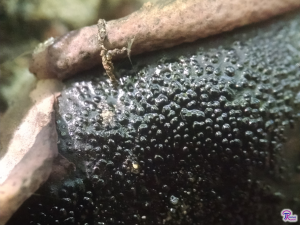
Each pimple on the Dog’s Nose Fungus connects to a perithecium, which produces the spore slime. The membrane in the top and left of this photo initially covers the mushroom but soon rips apart and curls back around the mushroom’s edges.
The outer membrane quickly breaks open to reveal a shiny black surface covered in black slime and dotted with pimples. Once the spore-producing surface is visible, the outer membrane curls backward to get out of the way. It remains around the edges of the mushroom as a brownish to blackish fringe of ragged tissue.1–3
The pimples on the surface are where the spores are released; each pimple connects to a long tube that terminates in a flask-shaped structure called a “perithecium.” The perithecia are lined with asci, which produce the spores. If you cut the mushroom in half (which will take some work, since the mushroom is pretty tough), you can easily see the blackish perithecia connected by tubes to the surface against the evenly brownish surrounding flesh (the flesh darkens to black near the base, but there are no perithecia that far down).1–3 Instead of releasing their spores into the air, the asci of C. petersii liquefy (“deliquesce” like inky cap gills, see FFF#177) to make a spore-containing slime that slowly exudes out of the perithecia. This creates the dark slime that coats the surface of the Dog’s Nose Fungus.1
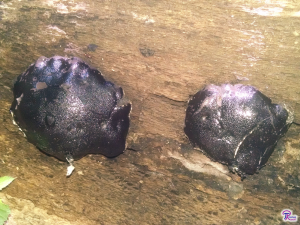
The membrane becomes less noticeable as the mushrooms grow. Old mushrooms also develop cracks and spots and dry out once they are done releasing spores.
As the mushroom grows, it can fuse with nearby mushrooms or develop bumps in its surface that distort its shape. However, the Dog’s Nose Fungus remains generally circular. In age, the edges are usually flattened to the substrate and the center curves out giving the mushroom a puffy appearance. If you dropped a dollop of bread dough onto a counter and let it rise, you would end up with a similar shape. Fully grown specimens of C. petersii range from 2cm to 7cm across (although they can reach sizes of up to 9cm across) and 2cm tall.1–3 The mushrooms are mostly attached at a single point and are therefore capable of forming a poorly-defined stipe in the right conditions.3 When not actively producing spores, the surface of the mushroom dries out and can lose some of its color, but it remains blackish and pimply and surrounded by membrane remnants.1,2 Old specimens sometimes have small smooth patches on their surface without warts or slime.
Ecology
C. petersii decomposes fallen oak logs that no longer have bark in North America from Kansas eastward, as far north as New England and south to Cuba. Although it appears only on oak today, it used to be a common sight on logs of American chestnut trees. Unfortunately, Chestnut Blight (another fungus) decimated those trees; consequently, the Dog’s Nose Fungus is probably rarer now than it used to be. The Dog’s Nose Fungus fruits from summer through fall.1–3
Weirdly, this mushroom doesn’t release its spores directly into the air. In most ascomycetes, the asci shoot their spores into the air like miniscule cannonballs. In C. petersii, however, the asci have lost this ability.1 What possible advantage could this confer to the mushroom? The slime sticks the spores to the surface of the mushroom, which prevents them from entering the air and dispersing. Spores are formed expressly to spread the fungus to new habitats, so embedding them in a layer of slime seems counterproductive.
Maybe the Dog’s Nose Fungus uses a strategy similar to stinkhorns (FFF#040) and Cedar-Apple Rust pycnia (FFF#087): the slime attracts certain insects, the insects walk around in the slime, the spore-filled slime sticks to the insects’ bodies, the insects deposit the spores wherever they land. This is a possible system, but I’ve never seen any bugs on this fungus.
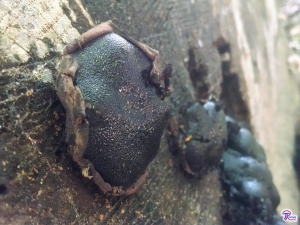
Why does the Dog’s Nose Fungus produce a spore slime instead of shooting its spores directly into the air?
Perhaps it uses a system that’s a bit simpler: the slime sticks the spores to the surface, the slime dries and leaves a mass of powdery spores, the spores are dispersed by raindrops next time it rains. This system is similar to that of earthballs (FFF#042) and Poronidulus conchifer (FFF#118), though neither of those need a slimy layer. If this is the correct explanation, the mushrooms should orient themselves horizontally so that as much of their surface as possible is exposed to falling raindrops. However, the mushrooms aren’t picky about which direction they fruit, suggesting access to raindrops isn’t important.
In inky caps, the gills liquefy so that the part of the gill actively producing spores is always at the bottom edge and has easy access to air currents. This doesn’t seem to apply to the Dog’s Nose Fungus because the mushroom isn’t designed to effectively drop spores into air currents. Its surface is rounded, so it should be oriented downward to allow spores from any part of the surface to fall down into the air. However, I’ve never seen the mushroom oriented that way; there is always some part of the surface facing upward. Of course, crust fungi also often have surfaces that face upward, so it must be possible for air currents to pick up spores from flat surfaces. This explanation begs the question, “The ancestors of C. petersii could fire their spores into the air, so why would the fungus evolve a less effective mechanism to accomplish the same thing?”
Do you have any other ideas about how C. petersii spreads its spores? If so, try to find evidence to support your ideas next time you find this mushroom! Of the explanations I came up with, I like the insect-mediated dispersal theory best. It could be that the mushroom attracts a specific insect – maybe one that is rarer today because its primary habitat was chestnut trees – which is why you don’t see lots of various insects all over the mushroom. Next: survey all the insects that routinely contact this mushroom (I really need to find an entomologist before attempting that project).
Similar Species
Honestly, I don’t know of any other species that really looks like C. petersii, except perhaps Canis lupus familiaris (the dog)4. The closest lookalikes to the Dog’s Nose Fungus are other mushrooms from the genus Camarops. Those fungi have surfaces with a similar shape and texture, but are not slimy and do not form a veil.5,6 Another potential point of confusion is Daldinia concentrica, which forms round mushrooms with a blackish pimply surface. D. concentrica does not form a veil, is not slimy, and features concentric rings when you cut it in half, making the fungus easy to distinguish from the Dog’s Nose Fungus.5
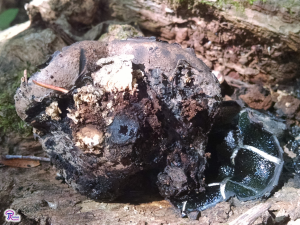
The specimen on the left was flipped over to show that it formed a small stipe. The stipe was cut to remove it from the log, and is visible as a black circle in the center of the mushroom. The Dog’s Nose Fungus on the right is deeply cracked due to very dry weather.
Taxonomy and Etymology
The common name “Dog’s Nose Fungus” is courtesy of a woman named Susan who attended a foray with Cornell mycologist Kathy Hodge. Kathy Hodge wrote a post about this in October 2007 (available here) and the name stuck.3,7 Other common names people have come up with include “Split Skin Carbon Cushion” and “Uncle Fester’s Eyeball Fungus.”1,5 The latter name comes from imaginative mind of Michael Kuo, author of MushroomExpert.com; his post was from February 2007, just months before Kathy Hodge offered up a catchier name.3 All these names are perfectly valid ways of describing this mushroom, but my personal favorite – in case you couldn’t tell – is “Dog’s Nose Fungus” because it really captures what the mushroom’s surface looks like.
C. petersii is named in honor of Judge Thomas M. Peters (from 1800’s Alabama), who collected and preserved the specimens that were used by mycologists when they originally described the species.6 The species belongs to the class Sordariomycetes in division Ascomycota.8 This class contains a lot of oddball ascos, including Cordyceps and its relatives (noted insect killers, see FFF#058), species of Hypomyces (they eat other fungi, see FFF#158), and Xylaria (such as Dead Man’s Fingers, FFF#005).9 Many of these species form perithecia that are visible as tiny bumps on the outer surface. In this respect, C. petersii is right at home in this group.
In the 2000’s, there was some effort to move the fungus out of the genus Camarops into Peridoxylon, but that was unsuccessful.7,8
| Kingdom | Fungi |
| Subkingdom | Dikarya |
| Division (Phylum) | Ascomycota |
| Subdivision (Subphylum) | Pezizomycotina |
| Class | Sordariomycetes |
| Subclass | Sordariomycetidae |
| Order | Boliniales |
| Family | Boliniaceae |
| Genus | Camarops |
| Species | Camarops petersii (Berk. & M.A. Curtis) Nannf.8 |
See Further:
http://www.mushroomexpert.com/camarops_petersii.html
https://blog.mycology.cornell.edu/2007/10/25/the-elusive-dogs-nose-fungus/
Citations
- Kuo, M. Camarops petersii. MushroomExpert.Com (2007). Available at: http://www.mushroomexpert.com/camarops_petersii.html. (Accessed: 15th June 2018)
- Emberger, G. Camarops petersii. Fungi Growing on Wood (2008). Available at: https://www.messiah.edu/Oakes/fungi_on_wood/puffball%20and%20cushion/species%20pages/Camarops%20petersii.htm. (Accessed: 15th June 2018)
- Beug, M. W., Bessette, A. & Bessette, A. R. Ascomycete fungi of North America: a mushroom reference guide. (2014).
- Canis lupus familiaris Linnaeus, 1758. Integrated Taxonomic Information System Available at: https://www.itis.gov/servlet/SingleRpt/SingleRpt?search_topic=TSN&search_value=726821#null. (Accessed: 15th June 2018)
- Vasilyeva, L., Stephenson, S. & Miller, A. Pyrenomycetes of the Great Smoky Mountains National Park. IV. Biscogniauxia, Camaropella, Camarops, Camillea, Peridoxylon and Whalleya. Fungal Diversity 25, 219–231 (2007).
- Péan, R., Bouet, C. & Gramain, D. Camarops polysperma(Montagne) J.H. Miller (1930) [1930-31]. Base de données mycologique (2017). Available at: http://www.mycodb.fr/fiche.php?genre=Camarops&espece=polysperma. (Accessed: 15th June 2018)
- Hodge, K. The elusive dog’s nose fungus. Cornell Mushroom Blog (2007).
- Camarops petersii. Mycobank Available at: http://www.mycobank.org/Biolomics.aspx?Table=Mycobank&Rec=45287&Fields=All. (Accessed: 15th June 2018)
- Kuo, M. Mushroom Taxonomy: The big picture. MushroomExpert.Com (2014). Available at: http://www.mushroomexpert.com/taxonomy.html. (Accessed: 15th June 2018)

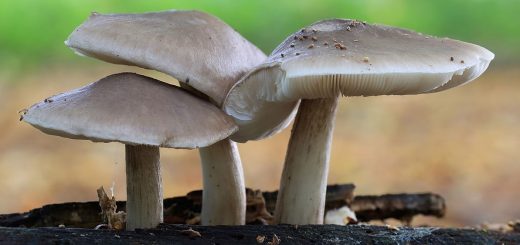






![#011: Characteristics of Kingdom Fungi [Archived]](https://www.fungusfactfriday.com/wp-content/themes/hueman/assets/front/img/thumb-small-empty.png)
